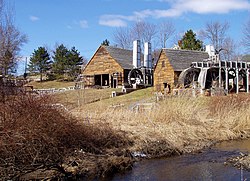Saugus Iron Works
|
Saugus Iron Works National Historic Site
|
|

Reconstructed Forge and Mill
|
|
| Location | 244 Central Street, Saugus, Massachusetts |
|---|---|
| Coordinates | 42°28′7″N 71°0′32″W / 42.46861°N 71.00889°WCoordinates: 42°28′7″N 71°0′32″W / 42.46861°N 71.00889°W |
| Area | 9 acres (0.04 km²) |
| Architect | Perry, Shaw & Hepburn, Kehoe & Dean |
| Visitation | 11,153 (2006) |
| Website | Saugus Iron Works National Historic Site |
| NRHP Reference # | 66000047 |
| Significant dates | |
| Added to NRHP | October 15, 1966 |
| Designated NHLD | November 27, 1963 |
| Designated NHS | April 5, 1968 |
Saugus Iron Works National Historic Site is a National Historic Site located about 10 miles (16 kilometers) northeast of Downtown Boston in Saugus, Massachusetts. It is the site of the first integrated ironworks in North America, founded by John Winthrop the Younger and in operation between 1646 and approximately 1670. It includes the reconstructed blast furnace, forge, rolling mill, shear, slitter and a quarter-ton drop hammer.
The facility is powered by seven large waterwheels, some of which are rigged to work in tandem with huge wooden gears connecting them. It has a wharf to load the iron onto ocean-going vessels, as well as a large, restored 17th-century house.
During the 17th century, iron was used to manufacture a number of indispensable goods, including nails, horseshoes, cookware, tools, and weapons. The production of iron required a complex manufacturing process that could only be done by an industrial enterprise. This process was not available in North America during the early years of English colonization, which meant that all iron goods had to be imported. As it took at least two months to sail to the nearest foundry, iron goods were very expensive.
Winthrop believed that because the colonies had a cheap and abundant supply of raw materials, an iron works in Massachusetts could produce goods that could be sold profitably in the New England and Chesapeake Colonies as well as in England itself. In 1641, Winthrop sailed to England to get the capital he needed to fund the enterprise. The Company of Undertakers for the Iron Workes [sic] in New England was founded to finance the project. Winthrop selected a site in Braintree, Massachusetts (now part of present-day Quincy, Massachusetts) as the location of the first Iron Works. Construction began in 1644 and was completed in 1645. On October 15, 1645, Winthrop secured the Undertakers an exemption from taxes and a 21-year monopoly on iron production from the Massachusetts General Court. The Braintree Iron Works, however, was unsuccessful due to a lack of iron ore in the area and an inadequate supply of water to power the machinery.
...
Wikipedia


